
- •1.1 Overview
- •1.2 Bridge resource management and the bridge team
- •1.2.1 Composition of the navigational watch under the STCW Code
- •1.2.4 Sole look-out
- •1.2.5 The bridge team
- •1.2.6 The bridge team and the master
- •1.2.7 Working within the bridge team
- •1.2.8 New personnel and familiarisation
- •1.2.9 Prevention of fatigue
- •1.2.10 Use of English
- •1.2.11 The bridge team and the pilot
- •1.3 Navigation policy and company procedures
- •1.3.1 Master's standing orders
- •2 Passage planning
- •2.1 Overview
- •2.2 Responsibility for passage planning
- •2.3 Notes on passage planning
- •2.3.1 Plan appraisal
- •2.3.2 Charts and publications
- •2.3.3 The route plan
- •2.4 Notes on passage planning in ocean waters
- •2.5 Notes on passage planning in coastal or restricted waters
- •2.5.1 Monitoring the route plan
- •2.6 Passage planning and pilotage
- •2.6.3 Pilot on board
- •2.6.4 Preparing the outward bound pilotage plan
- •2.8 Passage planning and ship reporting systems
- •2.9 Passage planning and vessel traffic services
- •3.2 Watchkeeping
- •3.2.2 General surveillance
- •3.2.3 Watchkeeping and the COLREGS
- •3.2.5 Periodic checks on navigational equipment
- •3.2.7 Calling the master
- •3.1 Overview
- •3.1.1 Master's representative
- •3.1.2 Primary duties
- •3.1.3 In support of primary duties
- •3.1.4 Additional duties
- •3.1.5 Bridge attendance
- •3.3 Navigation
- •3.3.1 General principles
- •3.3.2 Navigation in coastal or restricted waters
- •3.3.3 Navigation with a pilot on board
- •3.4.1 Use of the engines
- •3.4.2 Steering control
- •3.5 Radiocommunications
- •3.5.1 General
- •3.5.2 Safety watchkeeping on GMDSS ships
- •3.5.3 Log keeping
- •3.5.4 Testing of equipment and false alerts
- •3.6 Pollution prevention
- •3.6.1 Reporting obligations
- •3.7.1 General
- •3.7.2 Reporting
- •3.7.5 Piracy
- •4 Operation and maintenance of bridge equipment
- •4.1 General
- •4.2 Radar
- •4.2.1 Good radar practice
- •4.2.2 Radar and collision avoidance
- •4.2.3 Radar and navigation
- •4.2.4 Electronic plotting devices
- •4.3 Steering gear and the automatic pilot
- •4.3.1 Testing of steering gear
- •4.3.2 Steering control
- •4.3.3 Off-course alarm
- •4.4 Compass system
- •4.4.1 Magnetic compass
- •4.4.2 Gyro compass
- •4.4.3 Compass errors
- •4.4.4 Rate of turn
- •4.5 Speed and distance measuring log
- •4.5.1 Types of speed measurement
- •4.5.2 Direction of speed measurement
- •4.5.3 Recording of distance travelled
- •4.6 Echo sounders
- •4.8 Integrated Bridge Systems (IBS)
- •4.8.2 IBS equipment
- •4.8.3 IBS and the automation of navigation functions
- •4.8.4 Using IBS
- •4.9.1 Carriage of charts and nautical publications
- •4.9.2 Official nautical charts
- •4.9.3 Use of charts and nautical publications
- •4.9.4 Electronic charts and electronic chart display systems (if fitted)
- •4.10 Radiocommunications
- •4.10.1 GMDSS radiocommunication functions
- •4.10.3 Emergency communications
- •4.10.4 Routine or general communications
- •4.11 Emergency navigation lights and signalling equipment
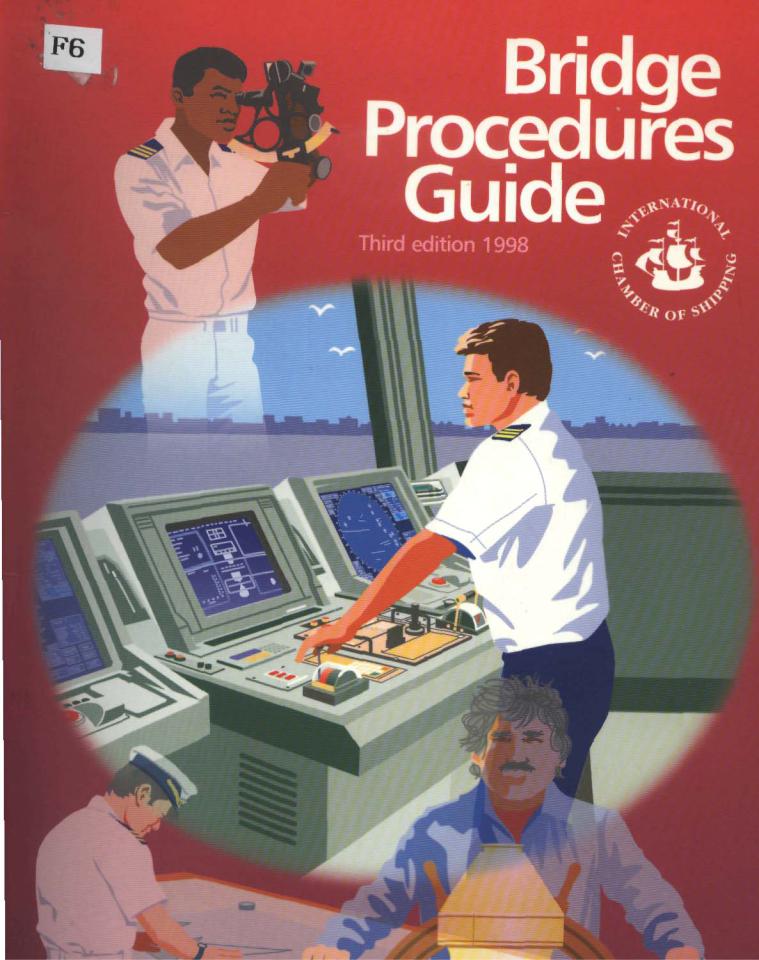
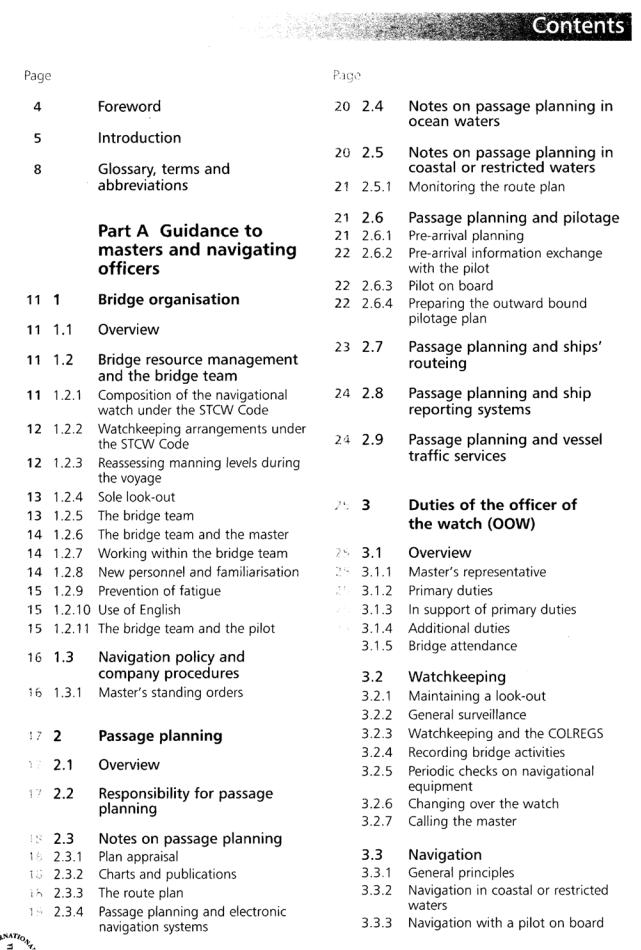
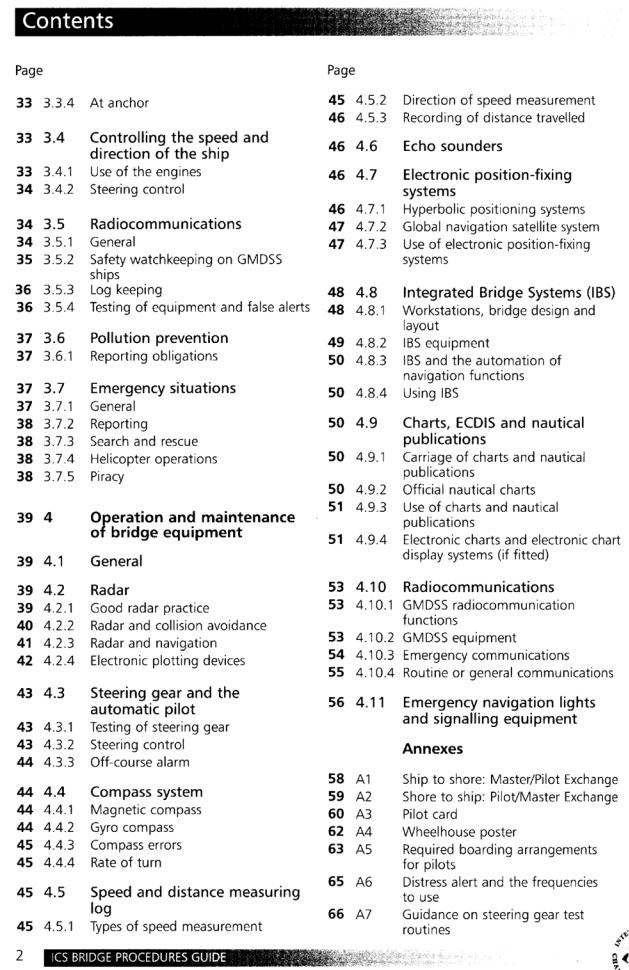
Page
Part B Bridge Checklists
69B1 Familiarisation with bridge equipment
70B2 Preparation for sea
71B3 Preparation for arrival in port
72 |
B4 |
Pilotage |
73 |
B5 |
Passage plan appraisal |
74B6 Navigation in coastal waters
75B7 Navigation in ocean waters
76B8 Anchoring and anchor watch
77B9 Navigation in restricted visibility
78B10 Navigation in heavy weather or
in tropical storm areas
79B11 Navigation in ice
80B12 Changing over the watch
81B13 Calling the master
|
|
Part C Emergency |
|
|
Checklists |
85 |
C1 |
Main engine or steering failure |
86 |
C2 |
Collision |
87 |
C3 |
Stranding or grounding |
88 |
C4 |
Man overboard |
89 |
C5 |
Fire |
90 |
C6 |
Flooding |
91 |
C7 |
Search and rescue |
92 |
C8 |
Abandoning ship |

Safe navigation is the most fundamental attribute of good seamanship. An increasingly sophisticated range of navigational aids can today complement the basic skills of navigating officers, which have accumulated over the centuries.
But sophistication brings its own dangers and a need for precautionary measures against undue reliance on technology. Experience shows that properly formulated bridge procedures and the development of bridge teamwork are critical to maintaining a safe navigational watch.
The first edition of the Bridge Procedures Guide was published 21 years ago, in 1977. Written to encourage good bridge watchkeeping practices, the Guide, updated in 1990, quickly made its mark and became acknowledged as the standard manual on the subject.
This third edition is the product of many months of revision and is intended to reflect best navigational practice today. Close attention has been paid to guidance on bridge resource management and in particular on passage planning, while the section on bridge equipment has been considerably expanded to take account of the more widespread use of electronic aids to navigation.
The assistance of experts from ICS member national shipowners' associations in the preparation of this Guide is warmly acknowledged. Special thanks are also due to colleagues from other maritime organisations, particularly the International Federation of Shipmasters' Associations, the International Maritime Pilots' Association and the Nautical Institute, who have willingly given their time and expertise to ensure that the Bridge Procedures Guide continues to offer the best possible guidance on the subject.
This Bridge Procedures Guide is divided into three parts and embraces internationally agreed standards, resolutions and advice given by the International Maritime Organization. Bridge and emergency checklists have been included for use as a guide for masters and navigating officers.
In particular, this Guide has been revised to take into account the 1995 amendments to STCW, the ISM Code and also the provision of modern electronic navigation and charting systems which, on new ships, are often integrated into the overall bridge design.
Above all the Guide attempts to bring together the good practice of seafarers with the aim of improving navigational safety and protecting the marine environment. The need to ensure the maintenance of a safe navigational watch at all times, supported by safe manning levels on the ship, is a fundamental principle adhered to in this Guide.
Finally, an essential part of bridge organisation is the procedures, which should set out in clear language the operational requirements and methods that should be adopted when navigating. This Bridge Procedures Guide has attempted to codify the main practices and provide a framework upon which owners, operators, masters, officers and pilots can work together to achieve consistent and reliable performance.
Seafaring will never be without its dangers but the maintenance of a safe navigational watch at all times and the careful preparation of passage plans are at the heart of good operating practice. If this Guide can help in that direction it will have served its purpose.
4

ICS attaches the utmost importance to safe navigation. Safe navigation means that the ship is not exposed to undue danger and that at all times the ship can be controlled within acceptable margins.
To navigate safely at all times requires effective command, control, communication and management. It demands that the situation, the level of bridge manning, the operational status of navigational systems and the ships' engines and auxiliaries are all taken into account.
It is people that control ships, and it is therefore people, management and teamwork which are the key to reliable performance. People entrusted with the control of ships must be competent to carry out their duties.
People also make mistakes and so it is necessary to ensure that monitoring and checking prevent chains of error from developing. Mistakes cannot be predicted, and once a mistake has been detected, it is human nature to seek to fit circumstances to the original premise, thus compounding a simple error of judgement.
Passage planning is conducted to assess the safest and most economical sea route between ports. Detailed plans, particularly in coastal waters, port approaches and pilotage areas, are needed to ensure margins of safety. Once completed, the passage plan becomes the basis for navigation. Equipment can fail and the unexpected can happen, so contingency planning is also necessary.
Ergonomics and good design are essential elements of good bridge working practices. Watchkeepers at sea need to be able to keep a look-out, as well as monitor the chart and observe the radar. They should also be able to communicate using the VHP without losing situational awareness. When boarding or disembarking pilots, handling tugs or berthing, it should be possible to monitor instrumentation, particularly helm and engine indicators, from the bridge wings. Bridge notes should be provided to explain limitations of any equipment that has been badly sited, pointing out the appropriate remedies that need to be taken.
The guiding principles behind good management practices are:
•clarity of purpose;
•delegation of authority;
•effective organisation;
•motivation.
Clarity of purpose
If more than one person is involved in navigating it is essential to agree the passage plan and to communicate the way the voyage objectives are to be achieved consistently and without ambiguity. The process starts with company instructions to the ship, as encompassed by a safety management system supported by master's standing orders and reinforced by discussion and bridge orders. Existing local pilotage legislation should also be ascertained to enable the master to be guided accordingly.
5

Before approaching coastal and pilotage waters, a ship's passage plan should ensure that dangers are noted and safe-water limits identified. Within the broad plan, pilotage should be carried out in the knowledge that the ship can be controlled within the established safe limits and the actions of the pilot can be monitored.
In this respect early exchange of information will enable a clearer and more positive working relationship to be established in good time before the pilot boards. Where this is not practicable the ship's plan should be sufficient to enable the pilot to be embarked and a safe commencement of pilotage made without causing undue delay.
Delegation of authority
The master has the ultimate responsibility for the safety of the ship. Delegation of authority to the officer of the watch (OOW) should be undertaken in accordance with agreed procedures and reflect the ability and experience of the watchkeeper.
Similarly, when a pilot boards the master may delegate the conduct of the ship to the pilot, bearing in mind that pilotage legislation varies from country to country and from region to region. Pilotage can range from optional voluntary pilotage that is advisory in nature, to compulsory pilotage where the responsibility for the conduct of the navigation of the ship is placed upon the pilot.
The master cannot abrogate responsibility for the safety of the ship and he remains in command at all times.
If the master delegates the conduct of the ship to the pilot, it will be because he is satisfied that the pilot has specialist knowledge, shiphandling skills and communications links with the port. In doing so the master must be satisfied that the pilot's intentions are safe and reasonable. The OOW supports the pilot by monitoring the progress of the ship and checking that the pilot's instructions are correctly carried out. Where problems occur which may adversely affect the safety of the ship, the master must be advised immediately.
The process of delegation can be the cause of misunderstanding and so it is recommended that a clear and positive statement of intention be made whenever handing over and receiving conduct of the ship.
When navigating with the master on the bridge it is considered good practice, when it is ascertained that it is safe to do so, to encourage the OOW to carry out the navigation, with the master maintaining a monitoring role.
The watch system provides a continuity of rested watchkeepers, but the watch changeover can give rise to errors. Consequently routines and procedures to monitor the ship's position and to avoid the possibility of mistakes must be built into the organisation of the navigational watch.
The risks associated with navigation demand positive reporting at all times, self verification, verification at handover and regular checks of instrumentation and bridge procedures. The course that the ship is following and compass errors must be displayed and checked, together with the traffic situation, at regular intervals and at every course change and watch handover.

Effective organisation
Preparing a passage plan and carrying out the voyage necessitates that bridge resources are appropriately allocated according to the demands of the different phases of the voyage.
Depending upon the level of activity likely to be experienced, equipment availability, and the time it will take should the ship deviate from her track before entering shallow water, the master may need to ensure the availability of an adequately rested officer as back-up for the navigational watch.
Where equipment is concerned, errors can occur for a variety of reasons and poor equipment calibration may be significant. In the case of integrated systems, it-is possible that the failure of one component could have unpredictable consequences for the system as a whole.
It is therefore essential that navigational information is always cross checked, and where there is doubt concerning the ship's position, it is always prudent to assume a position that is closest to danger and proceed accordingly.
Motivation
Motivation comes from within and cannot be imposed. It is however the responsibility of the master to create the conditions in which motivation is encouraged.
A valuable asset in any organisation is teamwork and this is enhanced by recognising the strengths, limitations and competence of the people within a team, and organising the work of the bridge team to take best advantage of the attributes of each team member.
Working in isolation when carrying out critical operations carries the risk of an error going undetected. Working together and sharing information in a professional way enhances the bridge team and the master/pilot relationship. Training in bridge resource management can further support this.
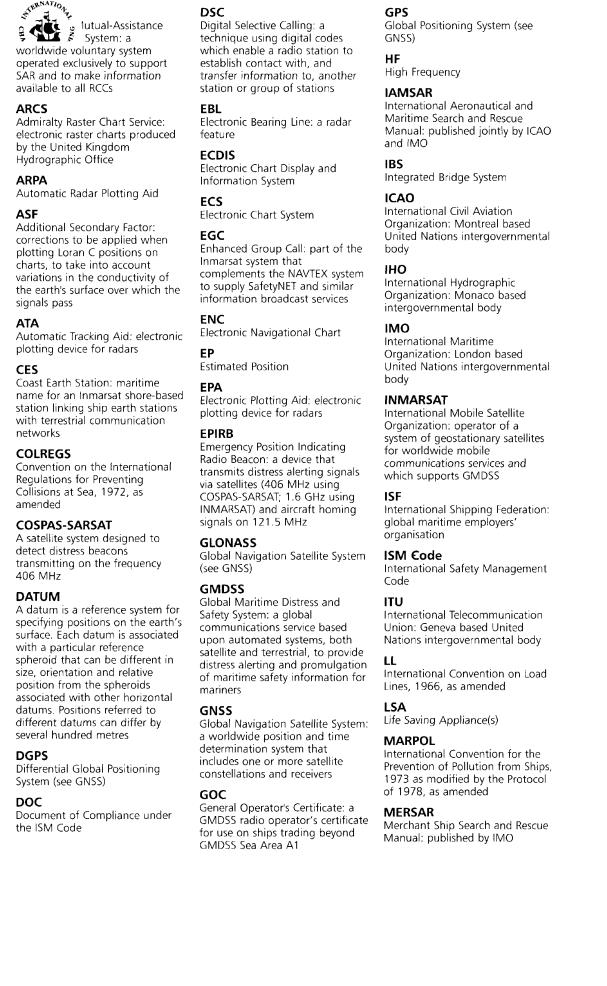
8
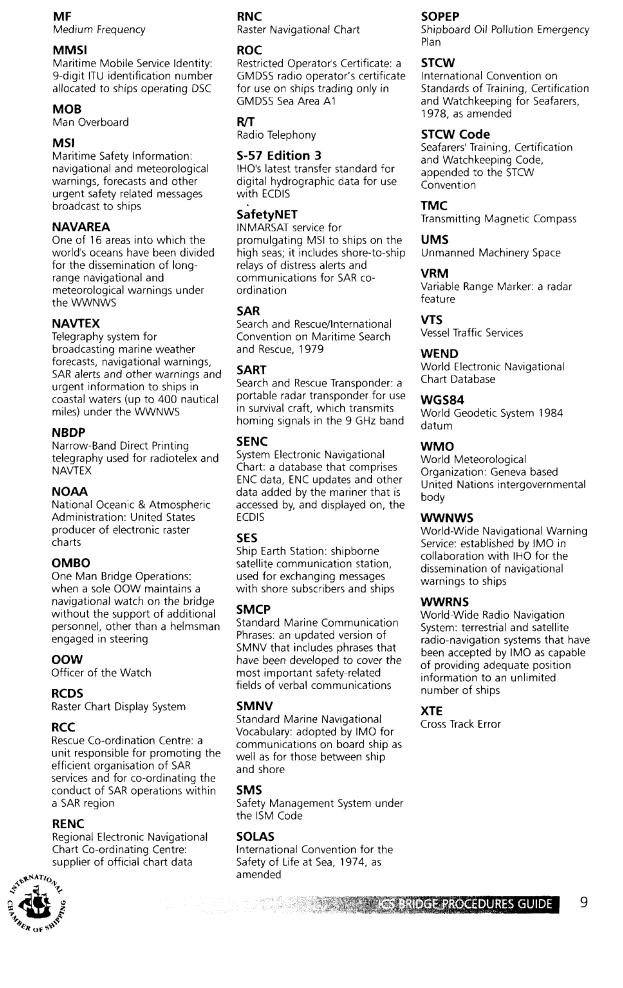
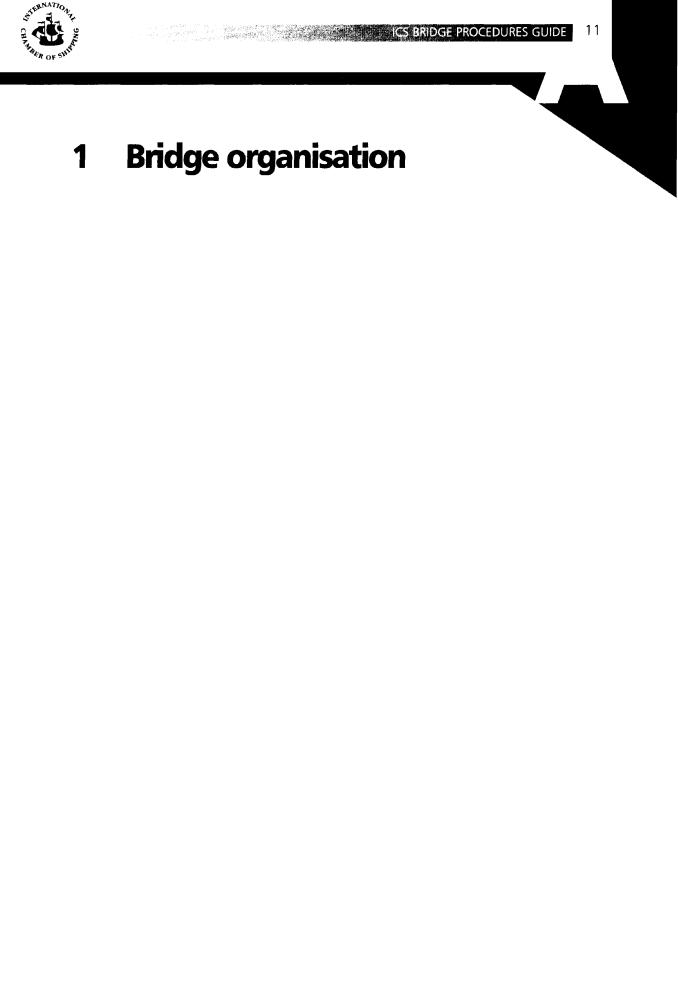
1.1Overview
General principles of safe manning should be used to establish the levels of manning that are appropriate to any ship.
At all times, ships need to be navigated safely in compliance with the COLREGS and also to ensure that protection of the marine environment is not compromised.
An effective bridge organisation should efficiently manage all the resources that are available to the bridge and promote good communication and teamwork.
The need to maintain a proper look-out should determine the basic composition of the navigational watch. There are, however, a number of circumstances and conditions that could influence at any time the actual watchkeeping arrangements and bridge manning levels.
Effective bridge resource and team management should eliminate the risk that an error on the part of one person could result in a dangerous situation.
The bridge organisation should be properly supported by a clear navigation policy incorporating shipboard operational procedures, in accordance with the ship's safety management system as required by the ISM Code.
1.2Bridge resource management and the bridge team
1.2.1Composition of the navigational watch under the STCW Code
In determining that the composition of the navigational watch is adequate to ensure that a proper look-out can be continuously maintained, the master should take into account all relevant factors including the following:
•visibility, state of weather and sea;
•traffic density, and other activities occurring in the area in which the ship is navigating;
•the attention necessary when navigating in or near traffic separation schemes or other routeing measures;
•the additional workload caused by the nature of the ship's functions, immediate operating requirements and anticipated manoeuvres;

•the fitness for duty of any crew members on call who are assigned as members of the watch;
•knowledge of and confidence in the professional competence of the ship's officers and crew;
•the experience of each OOW, and the familiarity of that OOW with the ship's equipment, procedures and manoeuvring capability;
•activities taking place on board the ship at any particular time, including radiocommunication activities, and the availability of assistance to be summoned immediately to the bridge when necessary;
•the operational status of bridge instrumentation and controls, including alarm systems;
•rudder and propeller control and ship manoeuvring characteristics;
•the size of the ship and the field of vision available from the conning position;
•the configuration of the bridge, to the extent such configuration might inhibit a member of the watch from detecting by sight or hearing any external development;
•any other relevant standard, procedure or guidance relating to watchkeeping arrangements and fitness for duty.
1.2.2Watchkeeping arrangements under the STCW Code
When deciding the composition of the watch on the bridge, which may include appropriately qualified ratings, the following factors, inter alia, must be taken into account:
•the need to ensure that at no time should the bridge be left unattended;
•weather conditions, visibility and whether there is daylight or darkness;
•proximity of navigational hazards which may make it necessary for the OOW to carry out additional duties;
•use and operational condition of navigational aids such as radar or electronic position-indicating devices and any other equipment affecting the safe navigation of the ship;
•whether the ship is fitted with automatic steering;
•whether there are radio duties to be performed;
•unmanned machinery space (UMS) controls, alarms and indicators provided on the bridge, procedures for their use and limitations;
•any unusual demands on the navigational watch that may arise as a result of special operational circumstances.
1.2.3Reassessing manning levels during the voyage
At any time on passage, it may become appropriate to review the manning levels of a navigational watch.

Changes to the operational status of the bridge equipment, the prevailing weather and traffic conditions, the nature of the waters in which the ship is navigating, fatigue levels and workload on the bridge are among the factors that should be taken into account.
A passage through restricted waters may, for example, necessitate a helmsman for manual steering, and calling the master or a back-up officer to support the bridge team.
1.2.4 Sole look-out
Under the STCW Code, the OOW may be the sole look-out in daylight conditions (see section 3.2.1.1).
If sole look-out watchkeeping is to be practised on any ship, clear guidance should be given in the shipboard operational procedures manual, supported by master's standing orders as appropriate, and covering as a minimum:
•under what circumstances sole look-out watchkeeping can commence;
•how sole look-out watchkeeping should be supported;
•under what circumstances sole look-out watchkeeping must be suspended.
It is also recommended that before commencing sole look-out watchkeeping the master should be satisfied, on each occasion, that:
•the OOW has had sufficient rest prior to commencing watch;
•in the judgement of the OOW, the anticipated workload is well within his capacity to maintain a proper look-out and remain in full control of the prevailing circumstances;
•back-up assistance to the OOW has been clearly designated;
•the OOW knows who will provide that back-up assistance, in what circumstances back-up must be called, and how to call it quickly;
•designated back-up personnel are aware of response times, any limitations on their movements, and are able to hear alarm or communication calls from the bridge;
•all essential equipment and alarms on the bridge are fully functional.
1.2.5The bridge team
All ship's personnel who have bridge navigational watch duties will be part of the bridge team. The master and pilot(s), as necessary, will support the team, which will comprise the OOW, a helmsman and look-out(s) as required.
The OOW is in charge of the bridge and the bridge team for that watch, until relieved.
It is important that the bridge team works together closely, both within a particular watch and across watches, since decisions made on one watch may have an impact on another watch.

The bridge team also has an important role in maintaining communications with the engine room and other operating areas on the ship.
1.2.6The bridge team and the master
It should be clearly established in the company's safety management system that the master has the overriding authority and responsibility to make decisions with respect to safety and pollution prevention. The master should not be constrained by a shipowner or charterer from taking any decision which in his professional judgement, is necessary for safe navigation, in particular in severe weather and in heavy seas.
The bridge team should have a clear understanding of the information that should be routinely reported to the master, of the requirements to keep the master fully informed, and of the circumstances under which the master should be called (see bridge checklist B13).
When the master has arrived on the bridge, his decision to take over control of the bridge from the OOW must be clear and unambiguous (see section 3.2.7).
1.2.7Working within the bridge team
1.2.7.1Assignment of duties
Duties should be clearly assigned, limited to those duties that can be performed effectively, and clearly prioritised.
Team members should be asked to confirm that they understand the tasks and duties assigned to them.
The positive reporting on events while undertaking tasks and duties is one way of monitoring the performance of bridge team members and detecting any deterioration in watchkeeping performance.
1.2.7.2Co-ordination and communication
The ability of ship's personnel to co-ordinate activities and communicate effectively with each other is vital during emergency situations. During routine sea passages or port approaches the bridge team personnel must also work as an effective team.
A bridge team which has a plan that is understood and is well briefed, with all members supporting each other, will have good situation awareness. Its members will then be able to anticipate dangerous situations arising and recognise the development of a chain of errors, thus enabling them to take action to break the sequence.
All non-essential activity on the bridge should be avoided.
1.2.8New personnel and familiarisation
There is a general obligation under the ISM Code and the STCW Convention for ship's personnel new to a particular ship to receive ship specific familiarisation in safety matters.
